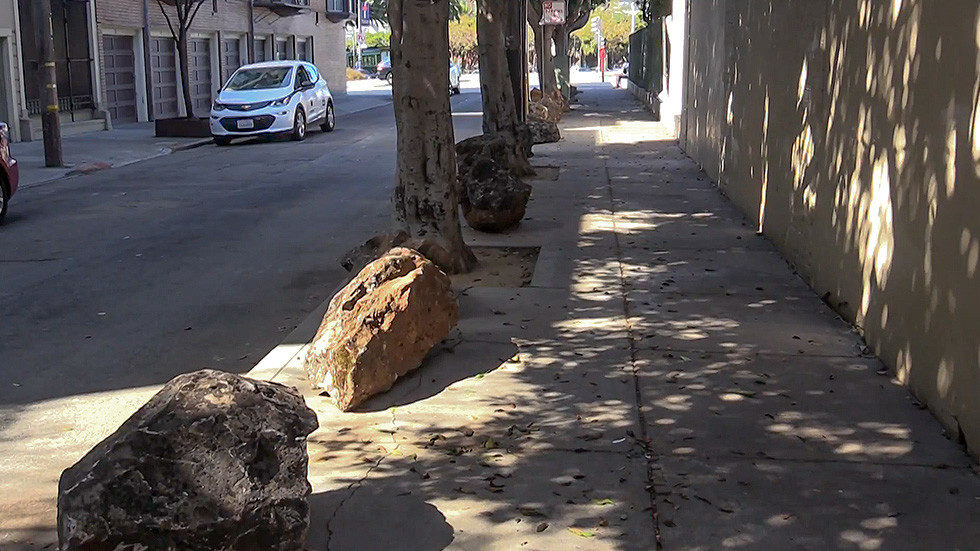
© RuptlyAnti-homeless rocks in Mission Dolores
San Francisco is one of the wealthiest cities in the US, but its high housing prices and strict zoning have contributed to a homelessness crisis.
The city has declared war on its rough sleepers - because housing them is too easy.
The latest offensive in the city's "war on homelessness" is sidewalk boulders - giant rocks placed along the sidewalk to deter homeless encampments. San Franciscans in the Mission Dolores neighborhood raised $2,000 to line their sidewalk with 24 large boulders to stop the homeless from setting up camp, using and selling drugs, and otherwise lowering the quality of life.
The plan, so far, has made matters worse -
the homeless set up tents anyway, forcing those who actually want to use the sidewalk for its intended purpose to walk on the street, and some locals have taken it upon themselves to remove the rocks - either by pushing them onto the street or (in the case of one enterprising woman) by listing them on Craigslist.
It's easy to sympathize with the residents - forced to
pool their resources to make their neighborhood safe because the government, for whatever reason, won't take steps to clear out the undesirables. But one of the reasons it's so expensive to live in San Francisco is the dire housing shortage, a problem that could easily be remedied if the
government cleared the way for the construction of more housing by altering the rigid zoning laws that prevent the construction of high-rise apartments, leaving a growing population to play "
musical chairs" with a static number of dwellings.
Instead, the city government "fights homelessness" by fighting the homeless - destroying semi-permanent large tent encampments and lining the sidewalks with metal barriers instead of boulders to make sure they don't rebuild - even though its
shelters have only space for about a tenth of San Francisco's homeless population. The city
passed a law in 2016 allowing for the "speedy dismantling" of tent camps. And as the homelessness problem has grown (with every one person housed, three more end up on the street,
according to the SF Chronicle), so have the borderline-sadistic approaches to quashing it.
Since the 1990s,
San Francisco has removed nearly all benches and public seating, hoping to deter the homeless from sleeping on them. Hydrophobic "
pee-proof paint" has been applied around the city to combat the problem of public urination - apparently cheaper than public toilets, it is a perfect example of solving the wrong problem, as the city continues to marinate in feces. A
"sit-lie" ordinance passed in 2010 made it illegal to so much as sit on the street; sporadic enforcement focused on tourist areas merely pushed the homeless into residential neighborhoods, and a 2018 court ruling
declared it unconstitutional to criminalize homelessness if no shelters were available. San Francisco's "
Homeward Bound" program ships the homeless out of the city to live with family and friends - probably the least disturbing of all the "
solutions," but still a band-aid on a gaping bullet wound.
Shocking videos of drug addicts shooting up in San Francisco metro stations have gone viral. The city's "poop problem" is the butt of jokes worldwide. Yet authorities shrug their shoulders when someone suggests installing public toilets or expanding the "tiny homes" project that has seen the homeless successfully housed in small shed settlements in neighboring Oakland. Instead, they focus their energies on
clearing away homeless encampments so their transient residents lack any sense of permanence (and the motivation to care for their makeshift homes).
When UN rapporteur on homelessness Leilani Farha visited San Francisco last year, she "
[couldn't] help but be completely shocked" by what she saw. Farhani suggested a moratorium on tent-clearing as the first step, admitting that solving the root causes of homelessness would take long-term effort, but long-term effort does not get politicians elected.
Addressing the root causes of homelessness would require acknowledging that half of the homeless end up on the street after their 50th birthday, chewed up and spat out by a society with no social safety net for individuals approaching retirement age or the elderly, and that 11 percent have a job that still doesn't pay for a roof over their head. It would require addressing the record high income inequality in the US in general and California in particular - an idea which causes most politicians to retreat in fear.
Comment: San Francisco's governing elites are worse than useless:
- San Francisco now an expensive, 'crap-covered cesspool' overwhelmed with crime & depression
- What criminals? Amid a crime epidemic, San Francisco attempts to sanitize depravity with PC language
- San Francisco is a sh*thole: The high cost of low-level crime
- Leftist utopia? Junkies and heroin addicts take over San Francisco metro station
Also listen to the hosts of Mind Matters discuss the roots of inequality: MindMatters: Origins of the Power Elite: Inequality and "The 1%"